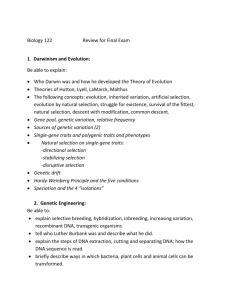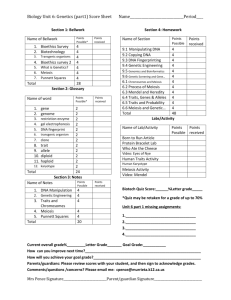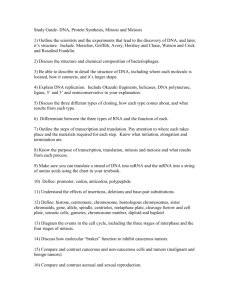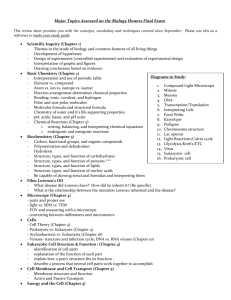DNA 1 Exam Review
advertisement
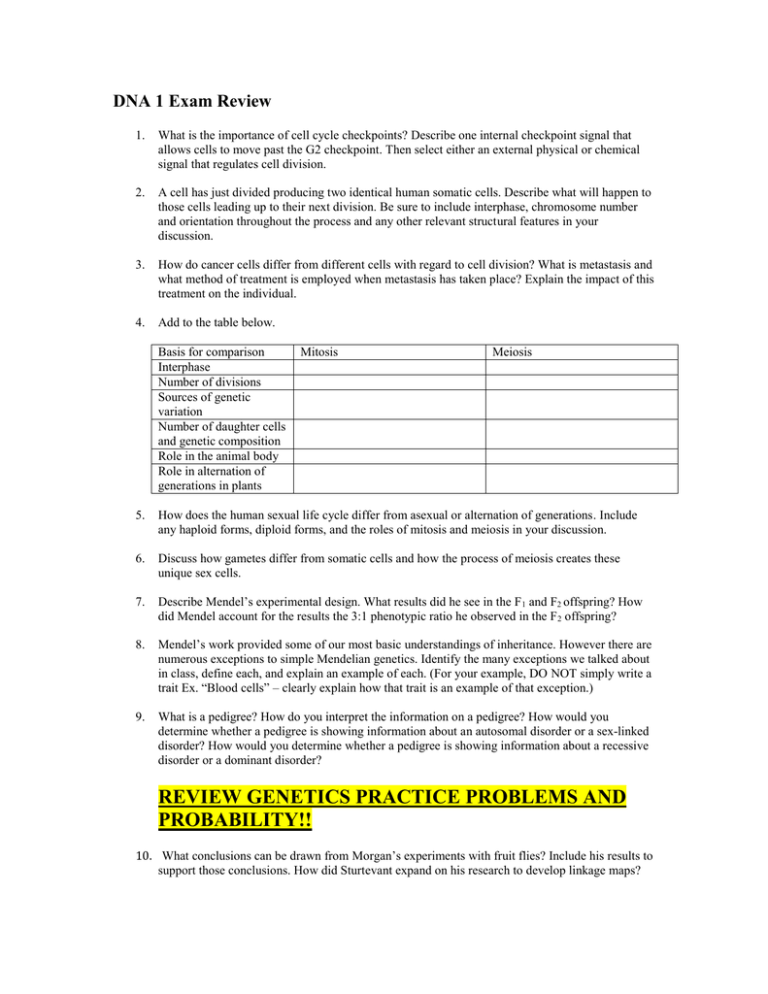
DNA 1 Exam Review 1. What is the importance of cell cycle checkpoints? Describe one internal checkpoint signal that allows cells to move past the G2 checkpoint. Then select either an external physical or chemical signal that regulates cell division. 2. A cell has just divided producing two identical human somatic cells. Describe what will happen to those cells leading up to their next division. Be sure to include interphase, chromosome number and orientation throughout the process and any other relevant structural features in your discussion. 3. How do cancer cells differ from different cells with regard to cell division? What is metastasis and what method of treatment is employed when metastasis has taken place? Explain the impact of this treatment on the individual. 4. Add to the table below. Basis for comparison Interphase Number of divisions Sources of genetic variation Number of daughter cells and genetic composition Role in the animal body Role in alternation of generations in plants Mitosis Meiosis 5. How does the human sexual life cycle differ from asexual or alternation of generations. Include any haploid forms, diploid forms, and the roles of mitosis and meiosis in your discussion. 6. Discuss how gametes differ from somatic cells and how the process of meiosis creates these unique sex cells. 7. Describe Mendel’s experimental design. What results did he see in the F 1 and F2 offspring? How did Mendel account for the results the 3:1 phenotypic ratio he observed in the F 2 offspring? 8. Mendel’s work provided some of our most basic understandings of inheritance. However there are numerous exceptions to simple Mendelian genetics. Identify the many exceptions we talked about in class, define each, and explain an example of each. (For your example, DO NOT simply write a trait Ex. “Blood cells” – clearly explain how that trait is an example of that exception.) 9. What is a pedigree? How do you interpret the information on a pedigree? How would you determine whether a pedigree is showing information about an autosomal disorder or a sex-linked disorder? How would you determine whether a pedigree is showing information about a recessive disorder or a dominant disorder? REVIEW GENETICS PRACTICE PROBLEMS AND PROBABILITY!! 10. What conclusions can be drawn from Morgan’s experiments with fruit flies? Include his results to support those conclusions. How did Sturtevant expand on his research to develop linkage maps? 11. A cell from a male human goes through meiosis and a nondisjunction event occurs in meiosis I on pair 23. First, what kind of gametes will result from meiosis? Secondly, if each of those types of gametes were to be involved in a fertilization event with a normal egg cell, what would the impact on the respective offspring be? 12. What are the different kinds of changes that effect chromosome structure and how do they interfere with the sequence? 13. Why would scientists have initially thought that proteins, not DNA, served as the genetic material in living things? How did the Hershey/Chase experiment confirm that DNA was the genetic material? REVIEW GRIFFITH, CHARGRAFF, AND MESELSON AND STAHL’S EXPERIMENTS AS WELL 14. Describe the movement of helicase, DNA polymerase III on the lagging strand, and DNA polymerase III on the leading strand in relationship to the origin of replication. How does replication on the lagging strand differ from replication on the leading strand? 15. What problem is presented by the 5’ end of a DNA strand and the fact that DNA polymerase can only add nucleotides to the 3’ end of the developing DNA strand? What structural feature on DNA strands protects against this problem? Explain the function and importance of telomerase. 16. How does protein synthesis differ between prokaryotes and eukaryotes? 17. Describe the structure of a ribosome and how tRNA and mRNA interact with the ribosome as translation takes place. 18. What are the different kinds of point mutations that can occur? How can they impact the proteins produced from that sequence?



